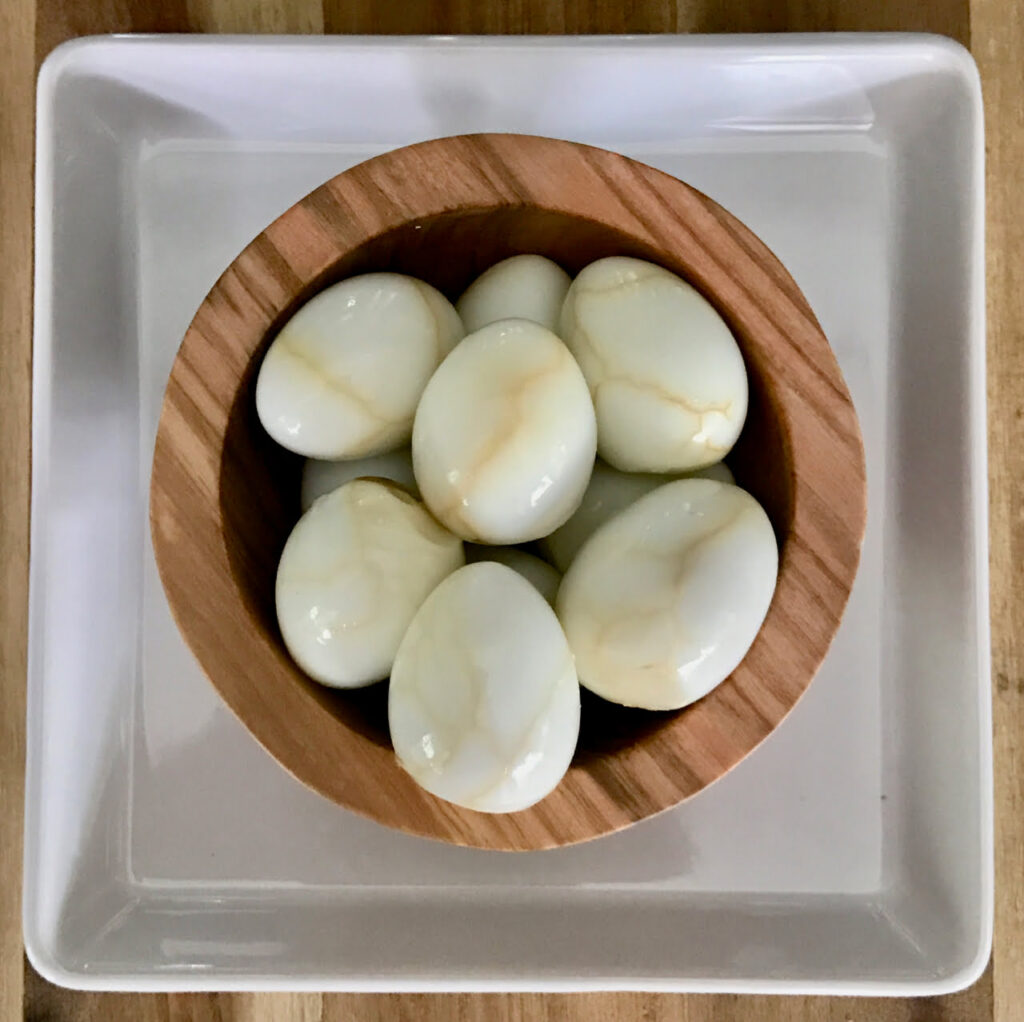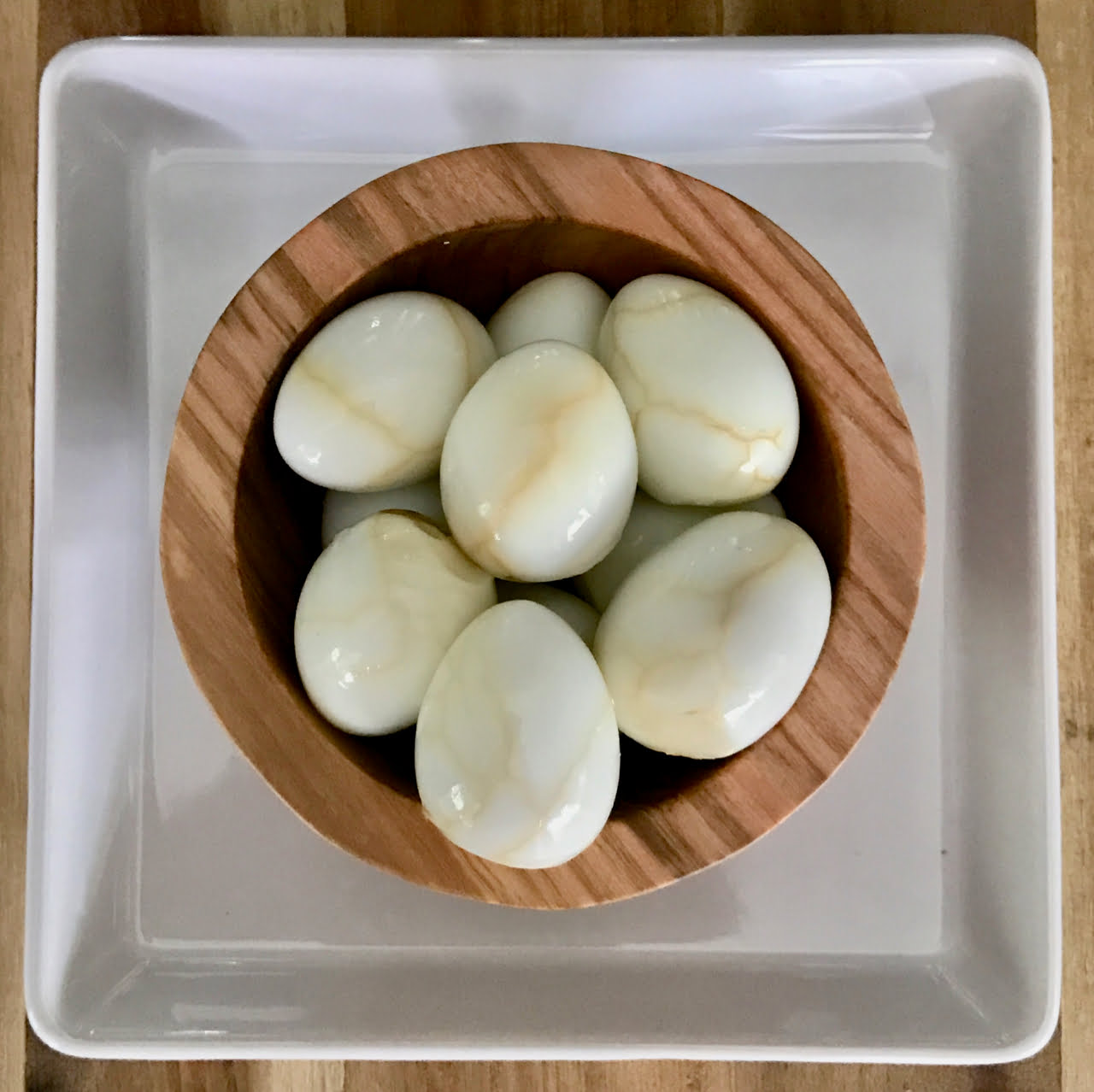Tea eggs are infused with flavor while boiling and have a beautiful, quail-egg-like appearance of marbleization when peeled.
Tea Eggs
While tea eggs are typically found in Chinese cuisine, the flavors you choose to infuse for your tea eggs can be a varied as your style of cooking.
I’m sorry to say I am not a fan of Chinese food. I much prefer Japanese food, for silly reasons that probably only matter to me. Also, the last thing I was after was a rubbery looking thousand year old egg. But what the ancient art of Chinese tea eggs have brought to the culinary world is nothing short of brilliant, and so I transformed an ancient style of cooking into something a bit more nouveau!
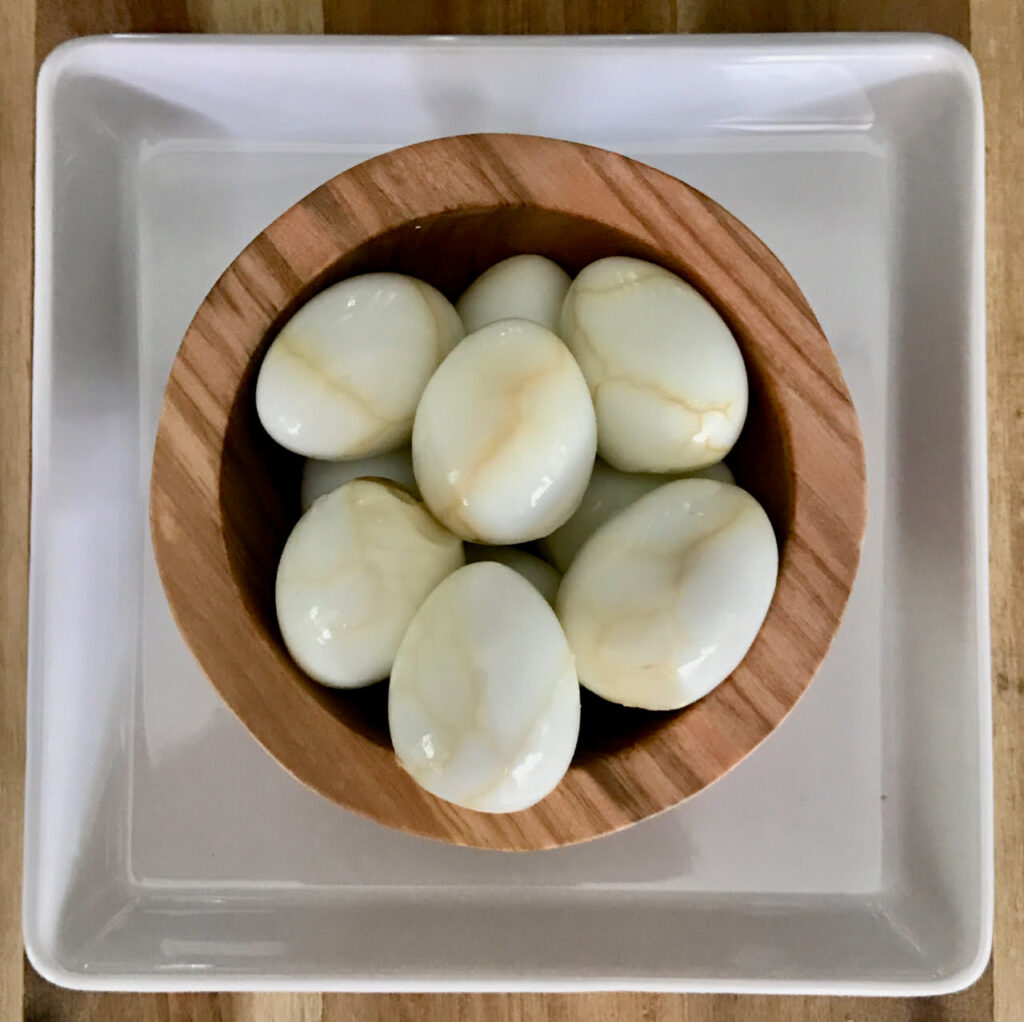
Chinese tea eggs can be infused with the heavy darker marble finish using dark soy sauce. To obtain an almost brown looking egg (after peeled), the eggs must be boiled twice. The second time is after lightly cracking the soft boiled egg, then adding soy sauce, wine or vinegar and a variety of spices to the simmer, therefore infusing as much flavor to the egg as you want during the second boil.
Western Tea Eggs
When I first experimented with tea eggs, I was not looking to infuse flavor to the eggs, it was purely esthetic! I found the beautiful marble design on a quail egg so attractive that I wanted to be able to peel the egg, after cooking, and have it look much the same as the shell.
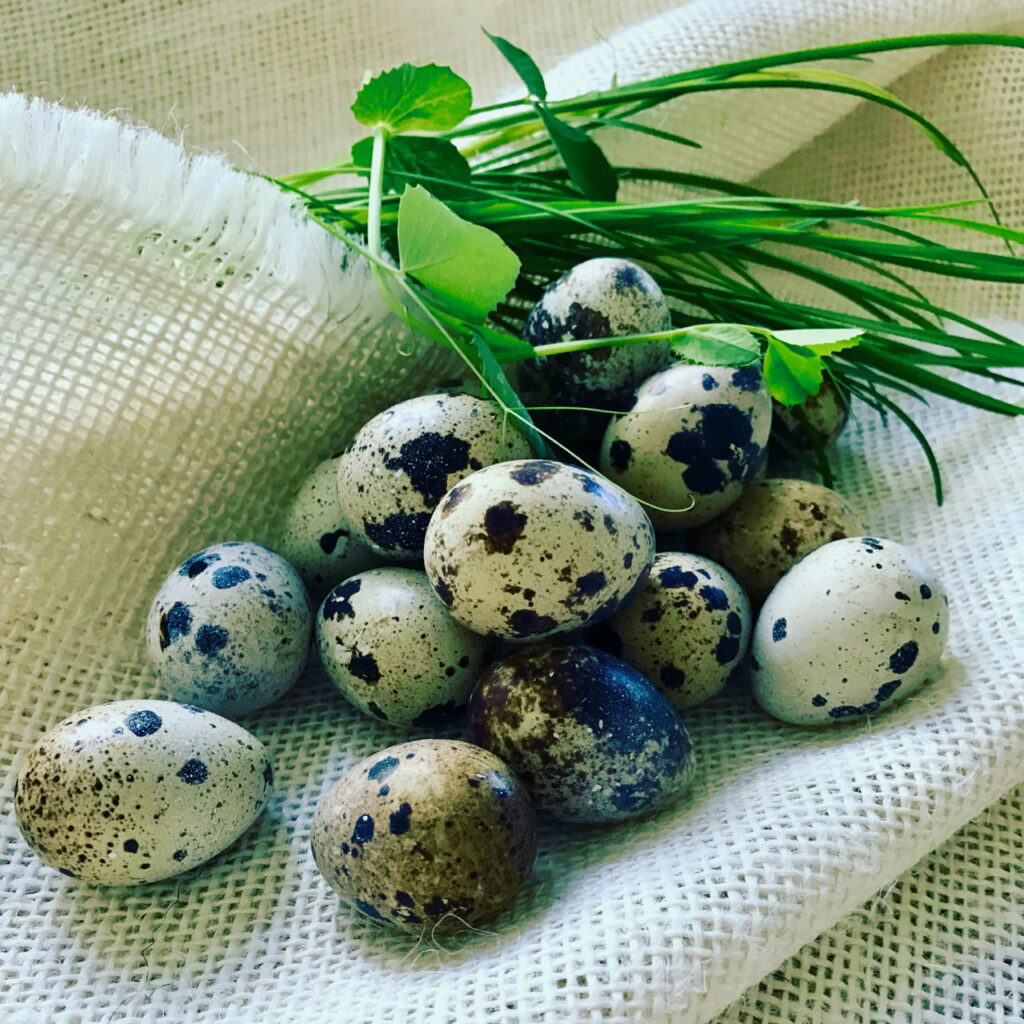
I was actually making a batch of a favorite summer salad I call ‘Salad In A Jar’. It’s a great way to pack a salad, with all the fixings, dressing included, without getting soggy and easy to transport for a summer outing. Since you can see all the ingredients in layers through the glass jar, I wanted the eggs to be pretty.
I did not double boil the eggs. I simply placed lots of loose Earl Grey tea (with that lovely bergamot flavor, kind of lemony), put a hand full of fresh oregano leaves, lemon wedges and a few sprigs of rosemary in the water and boiled them. After about 7 minutes, I turned off the heat and let the eggs just sit in the infused water until it cooled.
The result was a gently marble appearance and a lovely light garden flavor to the eggs. I like it so much better for a salad than heavy soy flavor with lots of more intense spices.
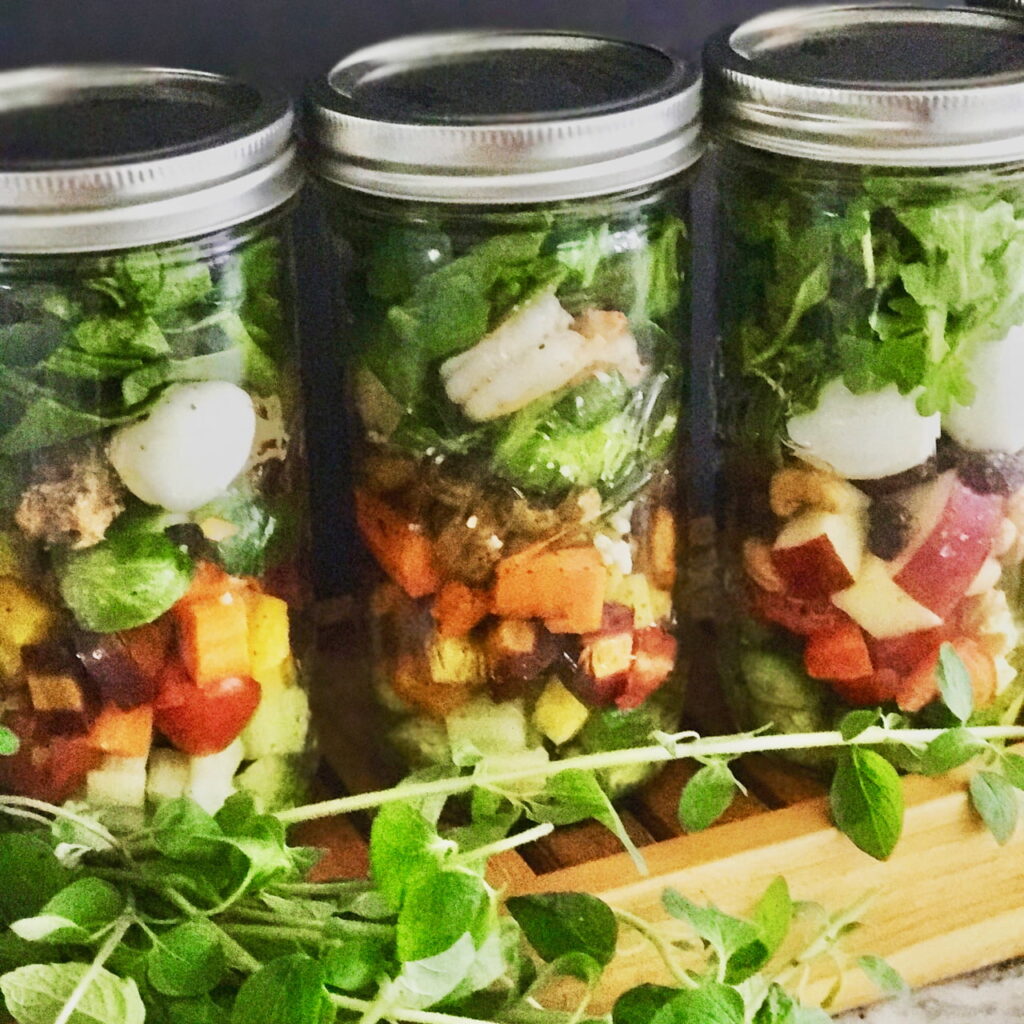
Tea As A Spice
Have you ever thought of tea as a spice? I know I never gave it much thought until I started playing around with flavors for my tea eggs. All of a sudden my huge tea collection became fair game as my spice rack.
For everyday tea sipping I tend to prefer a green jasmine tea. It is light in flavor and slightly floral. For evening tea sipping I lean more toward a chamomile tea, which is actually the floral buds, lighter in flavor and no caffeine. But for cooking… there are so many more choices to use tea as a spice.
Here are just a few more known teas to the western world, what flavor they impart which may help you decided how you might want to use them as a spice, not just for tea eggs but actually grind to a powder and use as a rub on meat, poultry and fish.
- Green teas will range anywhere from the light floral taste of jasmine tea to a heavier, grassy-type flavor of a gunpowder green tea.
- White tea is a delicate, light body tea with a crisp and clean flavor. Popular in the white tea family is white peony tea which makes for a gentle, slightly caffeine tea. Add a little cardamom to a few ground white tea leaves and you have a perfect delicate flavor for your favorite butter cookie!
- Pu-erh tea is partially fermented and makes for an almost ink brown-black color. Might be a great tea to use as a rub on pork or venison.
- Herbal and Floral teas, such as mint, lavender and chamomile do not have caffeine but do have very distinct flavor that can be used in the making of tea eggs or many other culinary delights. A minted tea egg might be the perfect infusion for eggs in my salad!
- Lapsang Souchong on the opposite side of the spectrum from herbal teas, is a black tea well known for its deep smoke flavor which is obtained as the tea leaves are given extra drying time over a smoking fire.
Nouveau Tea Eggs
If you have read this far, I think you will have, not only a new appreciation for a western tea egg but a nouveau understanding of how to use tea in a variety of ways in your kitchen. Heck… it has only been rather recent years that folks are now using coffee in cooking and coffee doesn’t hold a candle to the vast options of cooking with tea!
Ingredients Needed
- Quail eggs
- Earl Grey Tea
- Oregano leaves
- Rosemary leaves
- Water
- Lemon
Equipment Needed
- Cutting board
- Chopping knife
- Measuring cup
- Measuring spoons
- Sauce pan with lid
- Slotted spoon
- Stovetop or burner
Western Tea Eggs
Ingredients
- Quail eggs – 12, or regular eggs
- Loose Earl Grey Tea Leaves – 2 tablespoons
- Fresh oregano leaves – 1/4 cup
- Fresh rosemary leaves – 1 tablespoon
- Lemon – 1/2 lemon, cut in wedges
- Pot of water – enough to cover the eggs
Instructions
- Place enough cold water in a pot to cover the eggs of your choice. Add the quartered lemon wedges. Rough chop the herbs and lay those in the pot of water with the eggs and then add the tea leaves.
- Bring to a slow boil and let simmer for 7 minutes. Remove from the heat and allow to cool with everything in the pot. When ready to peel, remove the eggs and place in a bowl of ice water for a few minutes before peeling.
Notes
Nutrition
